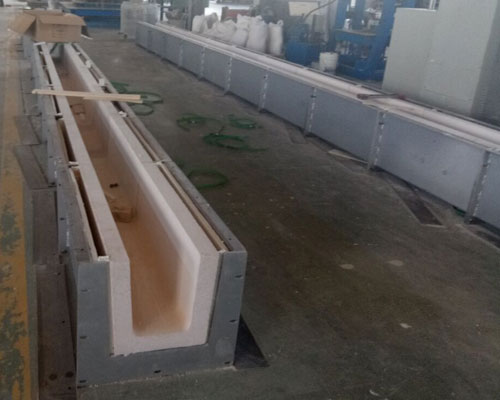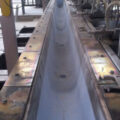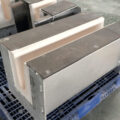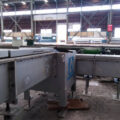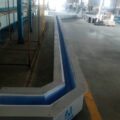The refractory lining of the aluminum silicate ceramic trough and launder is a separate element, which can be detached as an integral part and replaced so that the thermal insulation and/or the steel shell keeps installed in place. In that case, ceramic wool separates the compound from the steel jacket and makes it easy to replace the compound. The compound is anchored to the steel shell by means of fastening members, such as screws. The anchoring screws are screwed to the nuts, which have been cast in the compound, through the steel shell and the wool insulation.
The preferred temperature gradient described above is provided for the refractory lining, for example, by suitably selecting the thickness and the thermal insulation capacity of the insulation layer that is arranged between the refractory lining of the launder construction and the outer shell. A particularly preferred insulation material for the said insulating layer is ceramic wool insulation. The significance of the insulating layer is essential, as without it, the losses of heat are too great and the power required by the heating resistor will melt the resistor itself. On the other hand, if the insulation is too good, the molten metal, such as aluminum, is allowed to infiltrate through the ceramic refractory compound and the launder will leak.
The cover of the aluminum silicate ceramic launder is arranged on top of the launder so that no significant amounts of gases are able to discharge to the outside from between the cover and the launder, and no losses of heat will occur through radiation or gas flows. The surfaces of the cover and the launder, which are placed against each other, are preferably essentially even, whereby the launder supports the cover continuously at its long edges essentially throughout its length.
The aluminum silicate ceramic trough can reduce furnace temperature, improve furnace life, and reduce energy costs with a heated trough system. It is used to hold metal at temperature during transfer, the heated trough cover can control trough temperature. In addition, the heated trough system keeps refractory surfaces hot thus avoiding refractory thermal shock. The system also has the ability to preheat the trough before the introduction of liquid metal, maintaining the temperature of the metal.

